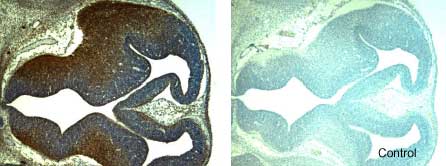Mouse GDF-5/BMP-14 Antibody
R&D Systems, part of Bio-Techne | Catalog # AF853


Key Product Details
Species Reactivity
Validated:
Cited:
Applications
Validated:
Cited:
Label
Antibody Source
Product Specifications
Immunogen
Ala376-Arg495
Accession # P43027
Specificity
Clonality
Host
Isotype
Scientific Data Images for Mouse GDF-5/BMP-14 Antibody
GDF‑5 in Mouse Embryo.
GDF-5 was detected in immersion fixed frozen sections of mouse embyro (12 d.p.c.) using 15 µg/mL Goat Anti-Mouse GDF-5 Antigen Affinity-purified Polyclonal Antibody (Catalog # AF853) overnight at 4 °C. Tissue was stained with the Anti-Goat HRP-DAB Cell & Tissue Staining Kit (brown; CTS008) and counterstained with hematoxylin (blue). View our protocol for Chromogenic IHC Staining of Frozen Tissue Sections.Detection of Mouse GDF-5/BMP-14 by Western Blot.
Western blot shows lysates of NIH-3T3 mouse embryonic fibroblast cell line. PVDF membrane was probed with 1 µg/mL of Goat Anti-Mouse GDF-5/BMP-14 Antigen Affinity-purified Polyclonal Antibody (Catalog # AF853) followed by HRP-conjugated Anti-Goat IgG Secondary Antibody (Catalog # HAF017). A specific band was detected for GDF-5/BMP-14 at approximately 55 kDa (as indicated). This experiment was conducted under reducing conditions and using Western Blot Buffer Group 1.Applications for Mouse GDF-5/BMP-14 Antibody
Immunohistochemistry
Sample: Immersion fixed frozen sections of mouse embyro (12 d.p.c.)
Western Blot
Sample: NIH‑3T3 mouse embryonic fibroblast cell line
Formulation, Preparation, and Storage
Purification
Reconstitution
Formulation
Shipping
Stability & Storage
- 12 months from date of receipt, -20 to -70 °C as supplied.
- 1 month, 2 to 8 °C under sterile conditions after reconstitution.
- 6 months, -20 to -70 °C under sterile conditions after reconstitution.
Background: GDF-5/BMP-14
Growth Differentiation Factor 5 (GDF-5), also known as cartilage-derived morphogenetic protein 1 (CDMP-1), is a member of the bone morphogenetic protein (BMP) family which belongs to the transforming growth factor beta (TGF-beta) superfamily. GDF-5 is synthesized as a large precursor protein that consists of an N-terminal 19 amino acid (aa) signal sequence, a 362 aa pro region, and a 120 aa C-terminal mature peptide. Mature GDF-5 is a homodimeric protein which contains the characteristic seven conserved cysteine residues. GDF-5, GDF-6, and GDF-7, which share 80-86% identity, define a new subgroup within the BMP family. Like other TGF-beta superfamily proteins, GDF-5 is highly conserved across species. At the amino acid sequence level, mature human and mouse GDF-5 are 98% identical. It has been reported that GDF-5 has multiple functions including regulation of myogenesis, regulation of chondrogenesis, bone morphogenesis, and neuron differentiation and survival. GDF-5 response is mediated by the formation of hetero-oligomeric complexes of type I (BMPR-IB) and type II (BMPR-II or Activin R-II) sereine/threonine kinase receptors, and the activation of Smad proteins (Smad 1, 5, and 8).
References
- Storm, E.E. et al. (1994) Nature 368:639.
- Nishitoh, H. et al. (1996) J. Biol. Chem. 271:21345.
- Francis-West, P.H. et al. (1999) Development 126:1035.
- Massague, J. et al. (2000) Genes and Dev. 14:627.
- Settle, S.H. Jr. et al. (2003) Dev. Biol. 254:116.
- Inada, M. et al. (1996) BBRC 222:317.
Long Name
Alternate Names
Gene Symbol
UniProt
Additional GDF-5/BMP-14 Products
Product Documents for Mouse GDF-5/BMP-14 Antibody
Product Specific Notices for Mouse GDF-5/BMP-14 Antibody
For research use only
